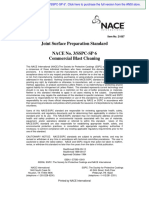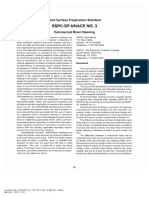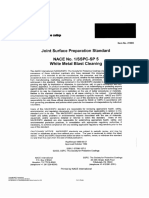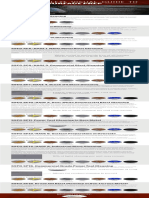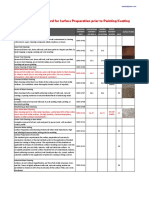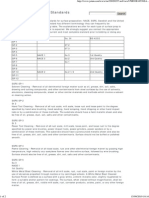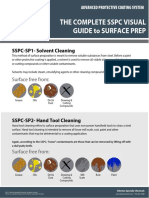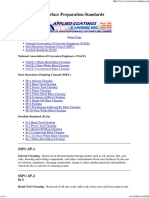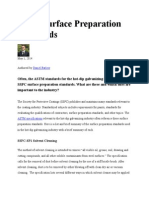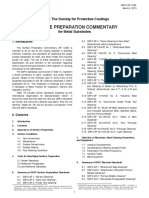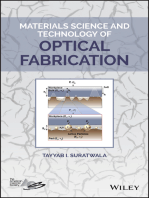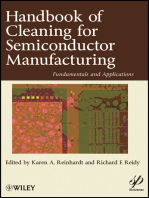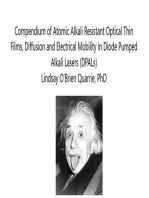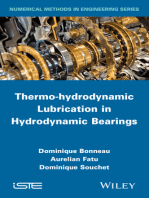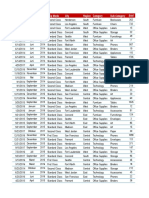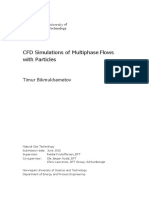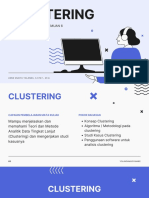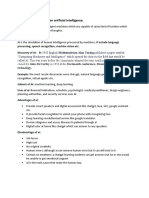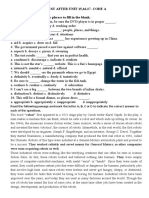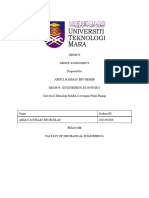SSPC-SP 18-2020
Uploaded by
Yusuf Luqman HakimSSPC-SP 18-2020
Uploaded by
Yusuf Luqman HakimSSPC-SP 18
December 30, 2020
Ssp[ � The Society for
Prote<:tive Coatings
SSPC: The Society for Protective Coatings
Surface Preparation Standard No. 18
Thorough Spot and Sweep Blast Cleaning
for Industrial Coating Maintenance
Foreword
1.2 This standard is limited to requirements for
This SSPC standard contains requirements for dry visible surface contaminants. Information on nonvisible
abrasive blast cleaning a previously coated carbon steel contamination is in nonmandatory Appendix A1. Information
surface to prepare retained coating for maintenance; and on soluble salt testing is in SSPC-Guide 15.
to clean areas of bare steel to near-white metal as defined
in SSPC-SP 10/NACE No. 2. Thorough spot and sweep 1.3 Information about the function of Thorough Spot
blast cleaning is used when the objective is to remove and Sweep Blast Cleaning is in Appendix A2. Appendix A3
all unserviceable coating, clean any exposed steel to a contains existing coating considerations for project planners
near-white metal cleanliness, and uniformly roughen the and managers.
remaining serviceable coating. Thorough spot and sweep
blast cleaning is designed to subject the entire surface 1.4 Units of Measure: This standard provides both
being prepared to significant abrasive impact. Coating that IEEE/ASTMI'I Sl 10 International System Units (SI) units
cannot withstand the abrasive blasting process is removed, and U.S. Customary units. Sl Units are presented first, with
while the remaining existing coating is suitably prepared for a conversion into approximate U.S. custom units shown in
an additional layer of coating. Areas of exposed steel are parentheses. The conversions are not exact; therefore, each
prepared to the level of near-white metal blast cleaning. This system must be used independently of the other.
standard is intended for use by coating or lining specifiers,
applicators, inspectors, or others whose responsibility 2: Definitions
is to define a standard degree of surface cleanliness for
2.1 Thorough Spot and Sweep Blast Cleaned
previously coated carbon steel surfaces.
Surface: A thorough spot and sweep blast cleaned surface,
when viewed without magnification, shall consist of areas of
In this standard, the terms shall and must are used to
exposed steel cleaned to near-white metal level as defined
state mandatory requirements. The term should is used
in Section 2.1.1, as well as areas of retained existing coating
to state something considered good and recommended
as described in Sections 2.1.2 and 2.1.3.
but not mandatory. The term may is used to state
something that is considered optional.
2.1.1 As defined in SSPC-SP 10/NACE No. 2, near
white blast cleaned steel surfaces shall be free of all visible
Scope
oil, grease, dust, dirt, mill scale, rust, coating, and other
foreign matter. Random staining shall be limited to no more
1.1 This standard contains the requirements for the
than 5 percent of each unit area of surface (approximately
Thorough Spot and Sweep Blast Cleaning degree of visible
5,800 mm2 [9.0 in2] (i.e., a square 76 mm x 76 mm [3.0 in x
surface cleanliness of previously coated steel surfaces by
3.0 in]), and may consist of light shadows, slight streaks, or
the use of dry abrasive blast cleaning. These requirements
minor discolorations caused by stains of rust, stains of mill
include the end condition of the surface as determined by
scale, or stains of previously applied coating.
visual inspection, and materials and procedures used to
achieve and verify the end condition. Thorough spot and
2.1.2 Retained existing coating shall have sufficient
sweep blast cleaning is designed to subject the entire
adhesion that it cannot be removed from the substrate by
surface being prepared to abrasive impact. Coating that
lifting with a dull putty knife. The borders of the retained
cannot withstand the abrasive blasting process is removed,
coating shall have no clear shoulder or edge at the coating/
while the remaining existing coating is suitably prepared for
substrate interface. If the coating can be dislodged, the area
application of an additional layer of coating. Areas of exposed
shall be rejected and cleaned again until the requirements
steel are prepared to the level of SSPC-SP 10/NACE No. 2.
of this standard are met. Coating that has been tapered by
This standard was developed by the SSPC C.2.21 Partial Blast Cleaning Committee 1'' IEEEIASTM Sl 10, American National Standard for Metric Practice, ASTM International,
and first issued in 2020. West Conshohocken, PA, 2017, <https:l/www.astm.org>
SSPC-SP 18
December 30, 2020
the blasting process in a manner that challenges adhesion 3.6 Coating thickness will vary among surfaces with
and removes all sharp edges is well adhered. Additional retained coating and, by definition, there will be no coating
information about evaluating the edges of retained coating is at all on surfaces blasted to near-white metal cleanliness
contained in Appendix A4. (SSPC-SP 10/NACE No. 2). Appendix A8 provides additional
information on final applied coating thickness.
2.1.3 Retained coating shall have no visible cracks,
blisters, delamination, or other defects after the blasting. The 4. Referenced Documents
retained coating shall not have chalking or residual corrosion
staining. The retained coating shall be uniformly roughened
4.1 The latest issue, revision, or amendment of the
and shall not have any area larger than 40 mm2 (�1/16 in)2
standards listed in Sections 4.3 through 4.6 shall govern
that exhibits the appearance of undisturbed coatings.
unless otherwise specified. Standards marked with an
Additional information about evaluating retained coating is
asterisk ( ) are referenced only in the Appendices, which are
*
contained in Appendix A4.
not requirements of this standard.
2.2 Spot Blasting: Localized abrasive blast cleaning
4.2 If there is a conflict between the requirements of any
as used in surface preparation for maintenance painting.
of the documents listed in Sections 4.3 through 4.6 and this
Often applied to specific areas where corrosion or coating
standard, the requirements of this standard shall prevail.
weaknesses are evident (e.g., blistering, delamination,
cracking). 4.3 SSPC and Joint Standards
2.3 Sweep Blasting: A fast pass of the abrasive
SSPC Guide Guide for Illumination of Industrial
blasting pattern over a surface to remove loose material and
12 Painting Projects
to roughen the surface sufficiently to successfully accept a
coat of paint. SSPC Guide Field Methods for Retrieval and
15 Analysis of Soluble Salts on Steel
Commentary: The techniques referred to as "sweep
and Other Nonporous Substrates
blasting" and "brush blasting" should not be confused with
the surface cleanliness level "brush-off blast cleaning" as SSPC-SP 1 Solvent Cleaning
defined in SSPC-SP 7/NACE No. 4. SSPC-SP 10/ Near-White Metal Blast Cleaning
NACE No. 2
3. Additional Technical Considerations SSPC-SP 10 Near-White Metal Wet Abrasive
(WAB)/NACE Blast Cleaning
3.1 Acceptable variations in appearance that do not WAB-2
affect surface cleanliness as defined in Section 2.1.1 include SSPC-AB 1 Mineral and Slag Abrasives
variations caused by the type of steel, original surface
SSPC-AB 2 Cleanliness of Recycled Ferrous
condition, thickness of the steel, weld metal, mill or fabrication
Metallic Abrasives
marks, heat treating, heat-affected zones, blasting abrasives,
SSPC-AB 3 Ferrous Metallic Abrasive
and differences resulting from the abrasive blast pattern.
SSPC-AB 4 Recyclable Encapsulated Abrasive
3.2 Appendices A4 and A5 provide additional information Media
on coating appearance. SSPC-PA 17 Procedure for Determining
Conformance to
3.3 The contractor shall prepare a sample area to serve Steel Profile/Surface Roughness/
as a Job Reference Standard (JRS) for the degree of surface Peak Count Requirements
preparation specified. The JRS shall be representative of SSPC-PA 2 Determining Conformance to Dry
the surface to be prepared. Following acceptance by the Coating Thickness Requirements
contracting parties, the JRS shall be documented, preserved, SSPC-SP Surface Preparation Commentary
or both, to serve as a reference for the duration of the project, COM for Steel Substrates
and all documentation shall be retained as part of the project
SSPC-SP Waterjet Cleaning of Metals - Very
records. In any dispute, the written definition set forth in this WJ-2/ Thorough Cleaning
standard shall take precedence over the JRS or other visual NACE WJ-2
comparators.
4.4 ASTM International Standards!2>
3.4 This standard shall be used only when the coating
to be applied on the prepared surface is determined to be
ASTM D3359 Standard Test Methods for
compatible with the existing coating.
Rating Adhesion by Tape Test
3.5 Appendix A6 provides guidance on the removal of "' ASTM International, 100 Barr Harbor Drive, West Conshohocken, PA 19428·2959,
pack rust and rust scale prior to blast cleaning. Appendix A7 phone int+1·6 10·832·9500. For referenced ASTM standards, visit the ASTM website
<http://www.astm.org>
provides examples of specification statements.
2
SSPC-SP 18
December 30, 2020
procurement documents (project specification). Appendix A9
ASTM D4285 Standard Test Method for
provides additional information.
Indicating Oil or Water
in Compressed Air
5.3 The condition of the coated steel prior to blast
ASTM D4414 Standard Practice for cleaning should be documented before the blast cleaning
Measurement of Wet Film commences.
Thickness by Notch Gages
ASTM D4417 Standard Test Methods for Field 6. Thorough Spot and Sweep Blast Cleaning
Measurement of Surface Profile Methods and Operation
of Blast Cleaned Steel
6.1 Any of the following methods of surface preparation
ASTM D6677 Standard Test Method for
Evaluating Adhesion by Knife can be used to achieve a Thorough Spot and Sweep Blast
Cleaned surface.
ASTM F21 Standard Test Method for
(1) Dry abrasive blasting using compressed air, blast
Hydrophobic Surface Films by
nozzles, and abrasive.
the Atomizer Test
(2) Dry abrasive blasting using a closed-cycle,
ASTM F22 Standard Test Method for recirculating abrasive system with compressed air,
Hydrophobic Surface Films by blast nozzle, and abrasive, with or without vacuum
the Water-Break Test for dust and abrasive recovery.
(3) Dry abrasive blasting using mobile, closed-cycle,
4.5 International Organization for Standardization
recirculating abrasive systems with centrifugal
(IS0)(3> Stand ard:
wheels and abrasive.
Hazardous materials may be present. Appendix A10
ISO 8502-3 "Preparation of steel substrates provides additional information.
before application of paints and
related products-Tests for the 6.2 Clean, dry compressed air shall be used for nozzle
assessment of surface cleanliness blasting. Cleanliness of the compressed air shall be verified
Part 3: Assessment of dust on steel in accordance with the procedure described in ASTM D4285.
surfaces prepared for painting Moisture separators, oil separators, traps, or other equipment
(pressure-sensitive tape method)" may be necessary to achieve this requirement.
4.6 NACE lnternational(4> Standards: 6.3 Wet abrasive blast cleaning (WAB) or pressurized
water cleaning methods may be substituted for dry abrasive
NACE 6G186 Surface Preparation of Soluble blast cleaning if specified in the contract documents. If WAB
Salt Contaminated Steel cleaning is used, the bare steel shall meet requirements of
Substrates Prior to Coating SSPC-SP 10 (WAB)/ NACE WAB-2. If pressurized water
cleaning is used, the bare steel shall meet requirements of
NACE SP0178 Design, Fabrication and
SSPC-SP WJ-2/NACE WJ-2.
Surface Finish Practices for
Tanks and Vessels to be Lined
6.3.1 Information on the use of inhibitors to prevent
for Immersion Service
the formation of rust immediately after cleaning with water
methods is contained in Appendix A11.
5. Procedures Before Thorough Spot and Sweep
Blast Cleaning 6.3.2 Surfaces prepared using wet methods should be
completely dry prior to coating application.
5.1 Precleaning: Visible deposits of oil and grease,
and heavy deposits of foreign matter such as mud, bird
7. Requirements for Blast Cleaning Abrasive
droppings, and caked salts shall be removed by methods in
Media
accordance with SSPC-SP 1, or as specified. Appendix A1
provides information about nonvisible contaminants.
7.1 Selection of abrasive size and type shall be based
on the type, grade, and surface condition of the steel to be
5.2 Before beginning cleaning, surface imperfections
cleaned, the type of blast cleaning system used, the finished
such as sharp edges, weld spatter, or burning slag shall
surface to be produced (cleanliness and surface profile
be removed from the surface to the extent required by the
[roughness]), and whether the abrasive will be recycled.
"' International Organization for Standardization (ISO). Case Postale 56, Geneva
CH-1211, Switzerland. In the United States, ISO standards may be obtained from the 7.2 The cleanliness and size of recycled abrasives
American National Standards Institute (ANSI) at <http://www.ansi.org>
''' NACE International, 15835 Park Ten Place, Houston,Texas 77084, USA, Phone:
shall be maintained to ensure compliance with this standard.
+ 1-281-228-6200
3
SSPC-SP 18
December 30, 2020
7.3 The blast cleaning abrasive shall be dry and free coating. Information on the effect of dew point (surface
of oil, grease, and other contaminants as determined by the condensation) is provided in Appendix A14.
test methods found in SSPC-AB 1, SSPC-AB 2, SSPC-AB 3
and SSPC-AB 4, as applicable, or according to requirements Appendix A. Explanatory Notes (Nonmandatory)
of the procurement documents (project specification).
This appendix is considered nonmandatory, although
7.4 The abrasive shall comply with any additional
it may contain mandatory language. It is intended only
specified requirements or limitations. Additional information
to provide supplementary information or guidance. The
on abrasive selection is in Appendix A12.
user of this standard is not required to follow, but may
choose to follow, any or all of the provisions herein.
7.5 The abrasive selected shall roughen the cleaned
surface to produce the surface profile specified in the
A1 NONVISIBLE CONTAMINATION: Nonvisible
procurement documents (project specification). If the surface
profile is not specified in the procurement documents, the contamination is the presence of organic matter, such as thin
abrasive selected shall roughen the cleaned surface to the films of oil and grease; and inorganic or soluble ionic materials
degree required by the product data sheet for the coating to such as chlorides, ferrous salts, nitrates, and sulfates
be applied. Additional information on surface profile and the that may be present on the substrate or retained coating.
film thickness of coating applied over the surface profile is in
A1.1 Steel contaminated with water-soluble salts (e.g.,
Appendices A8 and A13.
sodium chloride, potassium sulfate) may rapidly develop
8. Procedures Following Thorough Spot and rust-back. Rust-back can be minimized by removing these
Sweep Blast Cleaning and Immediately Prior to salts from the steel surface and eliminating sources of
Coating recontamination during and after cleaning. Water soluble
salts which remain embedded in retained coating may
8.1 Visible deposits of oil, grease, and other cause osmotic blistering of the new coating system. These
contaminants shall be removed by methods in accordance contaminants, along with their concentrations, may be
with SSPC-SP 1 or as specified. identified using the laboratory and field tests described in
SSPC-Guide 15. Information regarding methods commonly
8.2 Dust and loose residues shall be removed from used in removal of these contaminants can be found in
blast cleaned surfaces and retained coating by brushing; NACE Publication 6G186.
blowing off with clean, dry compressed air; vacuum cleaning;
or other methods specified in the procurement documents A1.2 Other nonvisible contaminants (e.g., oil, acid,
(project specification). base, silicone, wax) may have an effect on coating
performance. Coating manufacturers should be consulted
8.2.1 The presence of toxic metals in the abrasives for recommendations of maximum surface contamination
or coating being removed may place restrictions on the allowed. A visual water break test (ASTM F21 or F22) on the
methods of cleaning permitted. The chosen method shall surface may be used to detect hydrophobic contaminants.
comply with all applicable regulations. Ultraviolet ("black") light can also be used to detect films of
hydrocarbons on the surface. Appropriate eye protection
8.2.2 Cleanliness of the compressed air shall be verified should be worn when using ultraviolet light to inspect
in accordance with the procedure described in ASTM D4285. surfaces.
8.3 After blast cleaning, any surface imperfections A 1.3 The test method or procedure to be used for
(e.g., sharp edges, weld spatter, burning slag, scabs, slivers) determining the level of remaining nonvisible contaminants
shall be removed to the extent required in the procurement should be addressed in the procurement documents (project
documents (project specification). After removal of surface specification).
imperfections, the surface shall be reprofiled by blast
cleaning or other methods specified in the procurement A1.4 The level of nonvisible contaminants found in an
documents (project specification). Additional information on extraction from the surface that may remain on the surface is
surface imperfections is provided in Appendix A9. usually expressed as mass per unit area (�-tg/cm2 or mg/m2)
or as conductivity of a given test solution (JJS/cm).
8.4 Immediately prior to coating application, the
entire surface to be coated shall comply with the degree of A1.4.1 The following is an example specification for salt
cleanliness defined by this standard. Any visible rust that contamination based on concentration measurements:
forms on the surface of the steel after blast cleaning shall "Immediately prior to the application of the coating, the
be removed by blast cleaning or other methods specified in surface extract shall not contain more than [specify] Jlglcm2
the procurement documents (project specification) before [specify contaminant e.g., chloride, total salt] when tested
4
SSPC-SP 18
December 30, 2020
with a field test as described in SSPC-Guide 15 [or identify A3.3 Thorough spot and sweep blast cleaning may not
a specific method]. " be suitable for coatings that are not adequately challenged
by the abrasive blasting process to reveal latent film
A1.4.2 The following is an example specification for salt weaknesses. For example, loosely bonded coatings with
contamination based on conductivity measurements: high cohesive strength (e.g., glass-reinforced or elastomeric
"Immediately prior to the application of the coating, linings) may sufficiently resist abrasive blasting, retaining
the conductivity of the surface extract shall not exceed latent defects. A test area may be prepared to determine
[specify]11S/cm when tested with a field tests as described in if the thorough spot and sweep blast cleaning process is
SSPC-Guide 15 [or identify a specific method]." appropriate in such instances.
A4 E VALUATING RETAINED COATING: Inspectors
A2 FUNCTION: Thorough Spot and Sweep Blast
Cleaning is used when the objective is to remove all failing and blast cleaning craftworkers should use the following
or poorly adhered coatings, establishing a near-white metal guidance to evaluate surface with retained coating.
level of cleanliness on all exposed steel, and a thorough,
A4.1 Color can be a useful indicator for sufficiency of
uniformly roughened surface on all retained coatings. The
roughening of retained coatings. For example, removing
primary functions of blast cleaning before coating are:
yellowed/faded material can be a visual cue to blast cleaning
(a) To remove material from the surface that can cause craftworkers and inspectors that the existing coating was
early failure of the coating system; sufficiently blast cleaned. Similarly, removing the contrasting
(b) To obtain a suitable surface profile (roughness) to color of a finish coat is also a visual cue suggesting sufficient
enhance the adhesion of the new coating system; blast cleaning effort.
and
A4.2 The gloss or reflectance of adherent coating
(c) To facilitate a uniform, continuous coating film
can be useful in determining if a coating was adequately
across the surface being protected, minimizing the
challenged or uniformly roughened. In general, any retained
extent of borders between newly installed repair
coating should have no visible retained gloss or reflective
coating and the existing retained coating.
appearance after blast cleaning.
A3 EXISTING COATING CONSIDERATIONS: The
A4.3 Retained coating should exhibit a reasonably
following should be considered when planning a project
uniform appearance. The abrasive nozzle pattern used
using thorough spot and sweep blast cleaning procedures.
should not be visually obvious as evidenced by "streaks"
across the retained coating.
A3.1 Thorough spot and sweep blast cleaning is
intended to subject the existing coating to significant abrasive
A.4.4 The specifier may choose to require additional
impact. Coating that cannot withstand the abrasive blasting
cleanliness or roughness tests specifically for the retained
process should be removed. For thinner or less durable
coating. Traditional surface preparation inspection tests for
materials, this may result in removal of most of the existing
dust (ISO 8502-3), and surface profile (ASTM D4417) have
coating. More retained coating will remain for thicker, more
been used, though the standards are not written for polymer
durable materials. The objective of this standard is to leave
surfaces. For example, the surface profile of retained paint
coating that can withstand the abrasive blasting process, not
may be considerably deeper than profiled steel, which may
to retain as much extant coating as possible.
limit the ability to use some profile measurement techniques.
Visual inspections for embedded grit in the retained coating
A3.2 During abrasive blast cleaning, coating is removed
might also be considered, though there is not a current
either by the mechanism of impact or by the mechanism of
standard test method. Specific tests for adhesion of the
erosion. The intent of this standard is to remove the coating
retained coating such as ASTM D6677 or ASTM D3359 may
that can be removed by impact rather than erosion, and leave
also be specified.
coating which is sufficiently well adhered to resist impact.
During traditional full removal, a sufficiently adhered coating
A4.5 Visual inspections should be aided by a minimum
would require longer dwell times for the blast nozzle to erode
of 540 lux (�50 foot-candles) illumination per SSPC-Guide
off the existing coating (a more time-consuming process).
12 when inspecting a surface following blast cleaning to
SSPC-SP 18.
A3.3 Thorough spot and sweep blast cleaning should
only be specified when the existing, aged coating is AS PRE PARING AND E VALUATING EDGES OF
chemically compatible with the coating to be applied over RE TAINED COATING: The intent of this standard is to remove
it. Examples include replacing epoxy linings or maintaining as much of the underlying coating as is practical without the
zinc/epoxy/urethane coating systems. excessive effort that may be required for complete removal
of tightly adherent coating. The edges of retained coating
5
SSPC-SP 18
December 30, 2020
pose a performance risk if not properly prepared. The edges any circumstance allow the completed coating system to be
of retained coating meeting the requirements of Section 2.1 less than the specified thickness. Since the thickness of the
will generally exhibit a mottled, tapered appearance. While new and retained coating could be considerably higher than
the abrasive blasted edges may be described as "feathered," the required coating thickness, the specifier should consider
feathering using hand or power tools is neither beneficial nor requiring that coating thickness be determined according to
desired. SSPC PA 2, Coating Restriction Level 5.
A6 PACK RUST AND RUST SCALE: It may be helpful A8.3 It is beneficial to have alternative colors or other
to use hand or power tools to remove heavy deposits of visual distinction between the retained and newly applied
pack rust and rust scale before beginning the blast cleaning coating.
process.
A8.4 A uniform, continuous film over retained coating
A7 SPECIFICATION STATEMENTS: will not exhibit the roughness of the originally prepared
coating and should have sufficient hiding power to cover the
A7.1 The following are examples of specification aged coating.
statements:
"All surfaces to be recoated shall be cleaned in A8.5 In-process wet film thickness measurements
accordance with the procedures in SSPC-SP 18 and shall should be measured by the coating applicator per ASTM
meet the requirements of SSPC-SP 18 immediately prior to D4414 in order to ensure adequate film coverage. This can
coating application." be especially useful for ensuring proper coverage over areas
of retained coating.
"All surfaces to be recoated shall be cleaned in
accordance with the procedures in SSPC-SP 18 and shall A9 SURFACE IMPERFECTIONS:
meet the requirements of SSPC-SP 18 immediately prior to
coating application. Tightly adherent coating shall not remain A9.1 Surface imperfections that can cause premature
on more than [specify percentage] of the total area with no coating failure are often present. Coatings tend to pull away
single area of retained coating greater than [specify size of from sharp edges and projections, leaving little or no coating
the area] square feet." to protect the underlying steel. Other features that are
difficult to properly cover and protect include crevices, weld
A7.2 The specifier should consider whether a surface porosities, and laminations.
should be cleaned as required to achieve a particular, not to
exceed maximum, level of nonvisible contamination prior to A9.2 Poorly adhering fabrication defects, such as weld
recoating. Suggested specification statements for nonvisible slag residues, loose weld spatter, and surface laminations
contamination are given in Appendices A1.4.1 and A1.4.2. may be removed during the blast cleaning operation. Other
surface defects such as steel slivers, weld porosities, or deep
AS FILM THICKNESS: Coating thickness is critical corrosion pits may not be evident until the surface preparation
to adequate performance. At a minimum, the dry film has been completed. Therefore, proper planning for such
thickness of the entire coated area should meet the coating surface repair work should be given prior consideration,
manufacturer's recommended thickness, though areas of because the timing of the repairs may occur before, during,
retained coating may have a higher allowed thickness. To or after the blast cleaning operation. The SSPC-SP COM
ensure that coating thicknesses are properly measured, the and NACE SP0178 contain additional information on surface
procedures in SSPC-PA 2 for verification of accuracy of Type imperfections.
1 and Type 2 gages should be used.
A9.3 The high cost of the methods to remedy surface
A8.1 It is essential that ample coating be applied after imperfections (e.g., edge rounding and weld spatter
blast cleaning to adequately cover the peaks of the surface removal) should be compared with the benefits of preventing
profile of exposed steel. The dry film thickness of the coating premature coating failure. Therefore, those responsible for
above the peaks of the surface profile should be adequate establishing the requirements and those responsible for
for the desired protection. If the dry film thickness over the performing the work should agree on the procedures to be
peaks is inadequate, premature rust-through or coating used to repair surface imperfections to the extent required in
failure will occur. the procurement documents (project specification).
A8.2 Sufficient coating should be applied over the A10 HAZARDOUS MATERIAL: The presence of
retained coating to (a) provide a uniform, continuous film hazardous material in the coatings, cleaning media, or in
over the retained coating and bare metal and (b) meet the the work area itself can place restrictions on the methods
overall coating thickness requirements for the specified of cleaning permitted. Dry abrasive blast cleaning is often
system. The presence of an existing coating should not in
6
SSPC-SP 18
December 30, 2020
used to remove coatings with hazardous components. A13.2 The allowable minimum/maximum height
Applicable industrial hygiene tests should be performed, and of profile is usually dependent on the thickness of the
appropriate industrial hygiene practices should be followed. coating to be applied. Large abrasive particles (particularly
if metallic) can produce a surface profile that may be too
A11 USE OF CORROSION INHIBITORS: It may be high to be adequately covered by a single thin-film coat.
advantageous to add corrosion inhibitors to the surface Accordingly, the use of larger abrasives should be avoided
preparation water or apply them to the surface immediately in these cases. However, larger abrasives may be needed
after cleaning by wet methods in order to temporarily prevent for thick-film coatings or to facilitate removal of thick
rust formation. Some corrosion inhibitor treatments may coatings, heavy mill scale, or rust. If control of surface profile
interfere with the performance of certain coating systems. (minimum/maximum) is deemed to be significant to coating
The coating manufacturer should be consulted to ensure the performance, it should be addressed in the procurement
compatibility of corrosion inhibitors with the coatings. documents (project specification). Typical surface profile
heights achieved with commercial abrasive media are shown
A12 ABRASIVE SELECTION: Types of metallic and in Table 4 of SSPC-SP COM. The surface profile should be
nonmetallic abrasives are discussed in SSPC-SP COM. measured in accordance with AST M 04417 or as specified.
Blasting abrasives may become embedded in, or leave Compliance with specified profile requirements should be
residues on, the surface of the steel and retained coatings determined in accordance with SSPC-PA 17.
during cleaning. While such embedment or residues are
normally not detrimental, care should be taken to ensure A 13.3 While it is possible to measure the surface profile
that the abrasive is free from detrimental amounts of water of roughened coatings, for most purposes it is not necessary.
soluble, solvent-soluble, acid-soluble, or other soluble A visual assessment of the surface roughness uniformity is
contaminants (particularly if the cleaned steel is to be used adequate. If traditional techniques are employed to measure
in an immersion environment). Criteria for selecting and the roughness of the retained coating, profiles will generally
evaluating abrasives are found in SSPC-AB 1, SSPC-AB 2, be deeper and rougher than are commonly achieved with
SSPC-AB 3, and SSPC-AB 4. steel. Specification limits may also vary with the existing
coating type.
A13 SURFACE PROFILE:
A14 DEW POINT: Moisture condenses on any surface
A13.1 Surface profile is the roughness of the surface
that is colder than the dew point of the surrounding air.
that results from abrasive blast cleaning. Profile height
Therefore, the temperature of the steel surface should be
and uniformity is dependent on the size, shape, type,
at least 3 oc (5 °F) above the dew point during dry blast
and hardness of the abrasive, particle velocity and angle
cleaning and coating operations. It is advisable to visually
of impact, hardness of the surface, amount of abrasive
inspect for moisture and periodically check the surface
recycling, and the proper maintenance of working mixtures
temperature and dew point during blast cleaning operations
of grit and shot.
and to avoid the application of coating over a damp surface.
Copyright©
SSPC standards, guides, and technical reports are copyrighted
world-wide by SSPC: The Society for Protective Coatings. Any
photocopying, re-selling, or redistribution of these standards,
guides, and technical reports by printed, electronic, or any
other means is strictly prohibited without the express written
consent of SSPC: The Society of Protective Coatings and a
formal licensing agreement.
You might also like
- Surface Preparation Specification No. 15: SSPC: The Society For Protective CoatingsNo ratings yetSurface Preparation Specification No. 15: SSPC: The Society For Protective Coatings6 pages
- GP 44 31 Design and Location of Occupied Portable Buildings100% (3)GP 44 31 Design and Location of Occupied Portable Buildings17 pages
- ISO TS 50011 2023 Energy Management Systems Assessing Energy Management100% (1)ISO TS 50011 2023 Energy Management Systems Assessing Energy Management36 pages
- SSPC-VIS 1 Guía Fotográf - DRY ABRASIVE BLAST CLEANING) PDF100% (3)SSPC-VIS 1 Guía Fotográf - DRY ABRASIVE BLAST CLEANING) PDF34 pages
- 06 International Standard For Surface Preparation0% (1)06 International Standard For Surface Preparation1 page
- Especificaciones SSPC y Definiciones SP1-SPX PDFNo ratings yetEspecificaciones SSPC y Definiciones SP1-SPX PDF32 pages
- SSPC - Surface Preparation Standards: NotesNo ratings yetSSPC - Surface Preparation Standards: Notes2 pages
- Comparing Surface Prep Standards - SSPC - NACE and ISO 8501No ratings yetComparing Surface Prep Standards - SSPC - NACE and ISO 85015 pages
- VSC SSPC Visual Guide To Surface Prep PDFNo ratings yetVSC SSPC Visual Guide To Surface Prep PDF8 pages
- Surface Prep Standards - A Quick SummaryNo ratings yetSurface Prep Standards - A Quick Summary8 pages
- Table 4A Comparison of SSPC and Iso Surface Preparation Standards For Power-And Hand-Tool Cleaned Steel0% (1)Table 4A Comparison of SSPC and Iso Surface Preparation Standards For Power-And Hand-Tool Cleaned Steel2 pages
- Materials Science and Technology of Optical FabricationFrom EverandMaterials Science and Technology of Optical FabricationNo ratings yet
- Automated Optical Inspection: Advancements in Computer Vision TechnologyFrom EverandAutomated Optical Inspection: Advancements in Computer Vision TechnologyNo ratings yet
- Road to Excellence Advanced Concepts in Highway Engineering (Part-3)From EverandRoad to Excellence Advanced Concepts in Highway Engineering (Part-3)No ratings yet
- Technical Aspects Related to the Design and Construction of Engineered Containment Barriers for Environmental RemediationFrom EverandTechnical Aspects Related to the Design and Construction of Engineered Containment Barriers for Environmental RemediationNo ratings yet
- Handbook for Cleaning for Semiconductor Manufacturing: Fundamentals and ApplicationsFrom EverandHandbook for Cleaning for Semiconductor Manufacturing: Fundamentals and ApplicationsKaren A. ReinhardtNo ratings yet
- Chemical Modification of Solid Surfaces by the Use of AdditivesFrom EverandChemical Modification of Solid Surfaces by the Use of AdditivesNo ratings yet
- Compendium of Atomic Alkali Resistant Optical Thin Films, Diffusion and Electrical Mobility in Diode Pumped Alkali Lasers (DPALs)From EverandCompendium of Atomic Alkali Resistant Optical Thin Films, Diffusion and Electrical Mobility in Diode Pumped Alkali Lasers (DPALs)No ratings yet
- Metallic Oxynitride Thin Films by Reactive Sputtering and Related Deposition Methods: Process, Properties and ApplicationsFrom EverandMetallic Oxynitride Thin Films by Reactive Sputtering and Related Deposition Methods: Process, Properties and ApplicationsNo ratings yet
- Mathematical Analysis of Quasi-Simultaneous Laser Welding on PolymersFrom EverandMathematical Analysis of Quasi-Simultaneous Laser Welding on PolymersNo ratings yet
- Consolidated District Schoolformschecking Report100% (1)Consolidated District Schoolformschecking Report2 pages
- Clustering: Analisis Big Data - Pertemuan 6No ratings yetClustering: Analisis Big Data - Pertemuan 651 pages
- E TURTOR - BA200 - QTB - Aviation UnlimitedNo ratings yetE TURTOR - BA200 - QTB - Aviation Unlimited4 pages
- Partial Differential Equations Graphical User Interface Guide For Installing UsersNo ratings yetPartial Differential Equations Graphical User Interface Guide For Installing Users13 pages
- Project On A STUDY ON CONSUMER PERCEPTION OF FEDERAL BANK ATM SERVICES IN VALANCHERY AREANo ratings yetProject On A STUDY ON CONSUMER PERCEPTION OF FEDERAL BANK ATM SERVICES IN VALANCHERY AREA57 pages
- 3 Main Types of Moulding Machines - MetallurgyNo ratings yet3 Main Types of Moulding Machines - Metallurgy5 pages
- Optiplex 5090 Desktop Owners Manual10 en Us CON MARCASNo ratings yetOptiplex 5090 Desktop Owners Manual10 en Us CON MARCAS23 pages
- Hydraulic Control Valves - General: Hydrobloc System - Series KNo ratings yetHydraulic Control Valves - General: Hydrobloc System - Series K36 pages
- Training Design: Tulunan National High School Mini-TheaterNo ratings yetTraining Design: Tulunan National High School Mini-Theater8 pages
- Hear-Hi Invisible Rechargeable Digital Hearing AidsNo ratings yetHear-Hi Invisible Rechargeable Digital Hearing Aids2 pages






